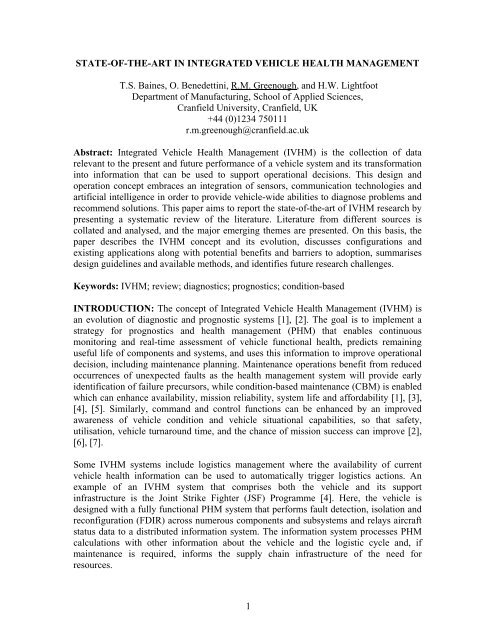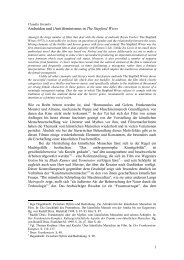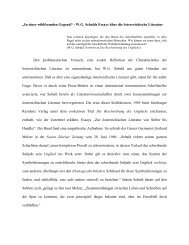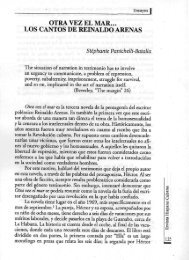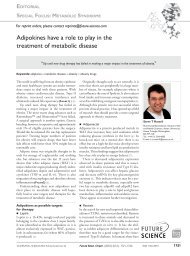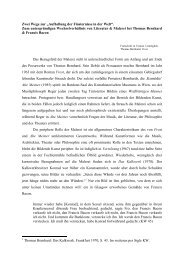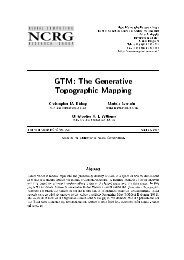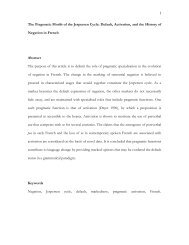PDF (State-of-the-art in integrated vehicle - Aston University ...
PDF (State-of-the-art in integrated vehicle - Aston University ...
PDF (State-of-the-art in integrated vehicle - Aston University ...
You also want an ePaper? Increase the reach of your titles
YUMPU automatically turns print PDFs into web optimized ePapers that Google loves.
STATE-OF-THE-ART IN INTEGRATED VEHICLE HEALTH MANAGEMENT<br />
T.S. Ba<strong>in</strong>es, O. Benedett<strong>in</strong>i, R.M. Greenough, and H.W. Lightfoot<br />
Dep<strong>art</strong>ment <strong>of</strong> Manufactur<strong>in</strong>g, School <strong>of</strong> Applied Sciences,<br />
Cranfield <strong>University</strong>, Cranfield, UK<br />
+44 (0)1234 750111<br />
r.m.greenough@cranfield.ac.uk<br />
Abstract: Integrated Vehicle Health Management (IVHM) is <strong>the</strong> collection <strong>of</strong> data<br />
relevant to <strong>the</strong> present and future performance <strong>of</strong> a <strong>vehicle</strong> system and its transformation<br />
<strong>in</strong>to <strong>in</strong>formation that can be used to support operational decisions. This design and<br />
operation concept embraces an <strong>in</strong>tegration <strong>of</strong> sensors, communication technologies and<br />
<strong>art</strong>ificial <strong>in</strong>telligence <strong>in</strong> order to provide <strong>vehicle</strong>-wide abilities to diagnose problems and<br />
recommend solutions. This paper aims to report <strong>the</strong> state-<strong>of</strong>-<strong>the</strong>-<strong>art</strong> <strong>of</strong> IVHM research by<br />
present<strong>in</strong>g a systematic review <strong>of</strong> <strong>the</strong> literature. Literature from different sources is<br />
collated and analysed, and <strong>the</strong> major emerg<strong>in</strong>g <strong>the</strong>mes are presented. On this basis, <strong>the</strong><br />
paper describes <strong>the</strong> IVHM concept and its evolution, discusses configurations and<br />
exist<strong>in</strong>g applications along with potential benefits and barriers to adoption, summarises<br />
design guidel<strong>in</strong>es and available methods, and identifies future research challenges.<br />
Keywords: IVHM; review; diagnostics; prognostics; condition-based<br />
INTRODUCTION: The concept <strong>of</strong> Integrated Vehicle Health Management (IVHM) is<br />
an evolution <strong>of</strong> diagnostic and prognostic systems [1], [2]. The goal is to implement a<br />
strategy for prognostics and health management (PHM) that enables cont<strong>in</strong>uous<br />
monitor<strong>in</strong>g and real-time assessment <strong>of</strong> <strong>vehicle</strong> functional health, predicts rema<strong>in</strong><strong>in</strong>g<br />
useful life <strong>of</strong> components and systems, and uses this <strong>in</strong>formation to improve operational<br />
decision, <strong>in</strong>clud<strong>in</strong>g ma<strong>in</strong>tenance plann<strong>in</strong>g. Ma<strong>in</strong>tenance operations benefit from reduced<br />
occurrences <strong>of</strong> unexpected faults as <strong>the</strong> health management system will provide early<br />
identification <strong>of</strong> failure precursors, while condition-based ma<strong>in</strong>tenance (CBM) is enabled<br />
which can enhance availability, mission reliability, system life and affordability [1], [3],<br />
[4], [5]. Similarly, command and control functions can be enhanced by an improved<br />
awareness <strong>of</strong> <strong>vehicle</strong> condition and <strong>vehicle</strong> situational capabilities, so that safety,<br />
utilisation, <strong>vehicle</strong> turnaround time, and <strong>the</strong> chance <strong>of</strong> mission success can improve [2],<br />
[6], [7].<br />
Some IVHM systems <strong>in</strong>clude logistics management where <strong>the</strong> availability <strong>of</strong> current<br />
<strong>vehicle</strong> health <strong>in</strong>formation can be used to automatically trigger logistics actions. An<br />
example <strong>of</strong> an IVHM system that comprises both <strong>the</strong> <strong>vehicle</strong> and its support<br />
<strong>in</strong>frastructure is <strong>the</strong> Jo<strong>in</strong>t Strike Fighter (JSF) Programme [4]. Here, <strong>the</strong> <strong>vehicle</strong> is<br />
designed with a fully functional PHM system that performs fault detection, isolation and<br />
reconfiguration (FDIR) across numerous components and subsystems and relays aircraft<br />
status data to a distributed <strong>in</strong>formation system. The <strong>in</strong>formation system processes PHM<br />
calculations with o<strong>the</strong>r <strong>in</strong>formation about <strong>the</strong> <strong>vehicle</strong> and <strong>the</strong> logistic cycle and, if<br />
ma<strong>in</strong>tenance is required, <strong>in</strong>forms <strong>the</strong> supply cha<strong>in</strong> <strong>in</strong>frastructure <strong>of</strong> <strong>the</strong> need for<br />
resources.<br />
1
IVHM is a potentially valuable strategy for <strong>the</strong> manufacture and management <strong>of</strong> <strong>vehicle</strong><br />
platforms. At present, <strong>the</strong>re is pressure to reduce costs for both military and commercial<br />
<strong>vehicle</strong> operators [6], so much attention is be<strong>in</strong>g given to <strong>the</strong> operational and support<br />
activities that contribute a large proportion <strong>of</strong> <strong>the</strong> lifecycle costs <strong>of</strong> modern <strong>vehicle</strong>s.<br />
Almost 95% <strong>of</strong> <strong>the</strong> lifecycle costs <strong>of</strong> commercial aircraft are attributable to ma<strong>in</strong>tenance<br />
activities [8]. Similarly, <strong>the</strong> US government has found that <strong>the</strong> cost <strong>of</strong> operat<strong>in</strong>g and<br />
support<strong>in</strong>g a <strong>vehicle</strong> may exceed <strong>the</strong> <strong>in</strong>itial purchase price by as much as ten times [9]. In<br />
this climate, it is clear that new generations <strong>of</strong> <strong>vehicle</strong> platforms will be subject to<br />
significant eng<strong>in</strong>eer<strong>in</strong>g change dur<strong>in</strong>g <strong>the</strong>ir lifecycles to ensure <strong>the</strong> most cost-effective<br />
field performance. The current justification for IVHM on both new and legacy <strong>vehicle</strong>s is<br />
<strong>the</strong> provision <strong>of</strong> <strong>in</strong>telligent technology to enable more cost-effective decisions on design,<br />
usage, and support [10].<br />
The concept <strong>of</strong> IVHM has been discussed <strong>in</strong> <strong>the</strong> literature for almost a decade [11] yet<br />
applications to date appear limited. Although many benefits are evident from <strong>the</strong><br />
literature, obstacles arise from <strong>the</strong> need to accurately evaluate <strong>the</strong> costs and benefits <strong>of</strong><br />
IVHM. Research to overcome <strong>the</strong>se obstacles requires a thorough and precise<br />
understand<strong>in</strong>g <strong>of</strong> exist<strong>in</strong>g knowledge, so <strong>the</strong> purpose <strong>of</strong> this paper is to describe <strong>the</strong> state<strong>of</strong>-<strong>the</strong>-<strong>art</strong><br />
<strong>of</strong> IVHM. The study described <strong>in</strong> this paper takes <strong>the</strong> form <strong>of</strong> a systematic<br />
literature review. Publication databases were searched us<strong>in</strong>g a range <strong>of</strong> key words<br />
associated with IVHM, and <strong>the</strong>n each <strong>art</strong>icle identified was reviewed. The outcome <strong>of</strong><br />
<strong>the</strong>se reviews was <strong>the</strong> extraction <strong>of</strong> a set <strong>of</strong> key f<strong>in</strong>d<strong>in</strong>gs that toge<strong>the</strong>r establish <strong>the</strong> state<strong>of</strong>-<strong>the</strong>-<strong>art</strong><br />
<strong>of</strong> IVHM.<br />
RESEARCH APPROACH: The authors’ <strong>in</strong>itial approach to this study has been to<br />
consider <strong>the</strong> follow<strong>in</strong>g questions:<br />
• What is an IVHM system and how is it commonly def<strong>in</strong>ed?<br />
• How does IVHM differ from conventional <strong>vehicle</strong> design and operation practices,<br />
and what are <strong>the</strong> consequences?<br />
• Where are <strong>the</strong> lead<strong>in</strong>g examples <strong>of</strong> IVHM application?<br />
• Where are <strong>the</strong> enablers and <strong>in</strong>hibitors <strong>of</strong> technical and economic success <strong>of</strong><br />
IVHM and what are <strong>the</strong> challenges to address <strong>in</strong> <strong>the</strong> future <strong>of</strong> IVHM<br />
development?<br />
The purpose <strong>of</strong> <strong>the</strong>se questions was to guide <strong>the</strong> search, with <strong>the</strong> authors be<strong>in</strong>g m<strong>in</strong>dful<br />
that exist<strong>in</strong>g literature may not be sufficient to allow <strong>the</strong>se to lead directly to key<br />
f<strong>in</strong>d<strong>in</strong>gs.<br />
Search strategy: The search first identified <strong>the</strong> relevant data sources, time frame and key<br />
words. Initially, a broad selection <strong>of</strong> databases was identified, cover<strong>in</strong>g academic<br />
journals, conference proceed<strong>in</strong>gs, books, technical reports and trade journals. Databases<br />
used <strong>in</strong>cluded IEEE, Scopus, Compendex, Inspec and Aerospace and High Technology<br />
Database, along with more traditional library catalogu<strong>in</strong>g systems. The time frame<br />
<strong>in</strong>itially <strong>in</strong>cluded only literature published between 2000 and 2007. However, this was<br />
later extended as a consequence <strong>of</strong> cross check<strong>in</strong>g citations. Keywords used <strong>in</strong>cluded:<br />
PHM, <strong>in</strong>tegrated diagnostics, embedded prognostics, remote monitor<strong>in</strong>g, remote<br />
2
diagnosis and management, <strong>in</strong>telligent sens<strong>in</strong>g, total health management, system-level<br />
assessment, <strong>in</strong>formed ma<strong>in</strong>tenance and on-board ma<strong>in</strong>tenance. The word ‘<strong>vehicle</strong>’ was<br />
<strong>of</strong>ten comb<strong>in</strong>ed as an additional keyword to ensure some direct association with <strong>the</strong> field<br />
<strong>of</strong> IVHM. The titles <strong>of</strong> all publications were checked to ensure relevance and abstracts<br />
were exam<strong>in</strong>ed before select<strong>in</strong>g publications for detailed analysis. An Internet search was<br />
also conducted us<strong>in</strong>g a similar process and <strong>the</strong> results <strong>of</strong> <strong>the</strong>se searches were comb<strong>in</strong>ed.<br />
Results and analysis: The search key words <strong>in</strong>itially identified some 70 publications. It<br />
was established that 34 <strong>of</strong> <strong>the</strong>m were suitable for review as p<strong>art</strong> <strong>of</strong> this research but<br />
subsequent cross check<strong>in</strong>g <strong>in</strong>creased <strong>the</strong> list to 42, and <strong>the</strong> analysis <strong>of</strong> <strong>the</strong>se publications<br />
forms <strong>the</strong> basis <strong>of</strong> <strong>the</strong> f<strong>in</strong>d<strong>in</strong>gs <strong>in</strong> this paper.<br />
KEY FINDINGS: The literature review process allowed n<strong>in</strong>e key f<strong>in</strong>d<strong>in</strong>gs to be<br />
established. This section presents each <strong>in</strong> turn.<br />
Def<strong>in</strong>ition <strong>of</strong> IVHM: There is no generally accepted def<strong>in</strong>ition <strong>of</strong> IVHM [8], yet various<br />
authors have proposed <strong>the</strong>ir own illustration <strong>of</strong> <strong>the</strong> concept (Table I). By compar<strong>in</strong>g <strong>the</strong><br />
various <strong>in</strong>terpretations, <strong>the</strong> concept <strong>of</strong> IVHM can be generalised as ‘<strong>the</strong> capture <strong>of</strong><br />
<strong>vehicle</strong> condition, both current and predicted, and <strong>the</strong> use <strong>of</strong> this <strong>in</strong>formation to enhance<br />
operational decisions, support actions and subsequent bus<strong>in</strong>ess performance’. Dur<strong>in</strong>g <strong>the</strong><br />
operation <strong>of</strong> an IVHM system, health data collected from <strong>vehicle</strong> components, structures<br />
and systems are and used to make diagnoses and prognoses <strong>of</strong> <strong>the</strong> present and future<br />
health <strong>of</strong> a <strong>vehicle</strong>. This <strong>in</strong>formation is <strong>the</strong>n fur<strong>the</strong>r processed to formulate appropriate<br />
operation and support actions and presented to <strong>the</strong> people who should execute <strong>the</strong><br />
actions. An important feature <strong>of</strong> IVHM is that health <strong>in</strong>formation must be used as p<strong>art</strong> <strong>of</strong><br />
<strong>the</strong> ma<strong>in</strong>tenance plann<strong>in</strong>g process <strong>in</strong>stead <strong>of</strong> merely be<strong>in</strong>g processed and archived for<br />
later use. This dist<strong>in</strong>guishes health management from health monitor<strong>in</strong>g [12], [13].<br />
A second important feature <strong>of</strong> IVHM is <strong>the</strong> notion <strong>of</strong> <strong>in</strong>tegration. The health management<br />
system will consider <strong>the</strong> <strong>vehicle</strong> as a whole ra<strong>the</strong>r than be<strong>in</strong>g implemented separately on<br />
<strong>in</strong>dividual subsystems and components [14], [15]. As an <strong>in</strong>tegrated approach, <strong>the</strong> IVHM<br />
system will improve <strong>the</strong> isolation <strong>of</strong> <strong>the</strong> root causes <strong>of</strong> failures as well as facilitat<strong>in</strong>g<br />
improved decision mak<strong>in</strong>g throughout <strong>the</strong> lifecycle. Although most authors see IVHM as<br />
a reliability and ma<strong>in</strong>ta<strong>in</strong>ability concept, and some l<strong>in</strong>k IVHM applications with<br />
automated logistics coord<strong>in</strong>ation [7], [16], [17] <strong>the</strong>re are those who see <strong>the</strong> ultimate<br />
<strong>in</strong>stantiation <strong>of</strong> IVHM as a competitive proposition for aftercare service providers [1],<br />
[10]. Such authors refer to <strong>the</strong> <strong>in</strong>creased viability <strong>of</strong> performance-based arrangements<br />
through IVHM however this concept does not appear <strong>in</strong> any <strong>of</strong> <strong>the</strong> def<strong>in</strong>itions.<br />
F<strong>in</strong>d<strong>in</strong>g 1: An IVHM system is a condition monitor<strong>in</strong>g system that delivers value <strong>in</strong><br />
support<strong>in</strong>g efficient fault reaction plann<strong>in</strong>g. IVHM <strong>of</strong>fers a capability to make<br />
<strong>in</strong>telligent, <strong>in</strong>formed, appropriate decisions about operation, ma<strong>in</strong>tenance and<br />
logistics based on <strong>the</strong> assessment <strong>of</strong> present and future <strong>vehicle</strong> condition. The<br />
IVHM logic is premised on <strong>in</strong>tegrat<strong>in</strong>g <strong>vehicle</strong> components and subsystems to<br />
both <strong>in</strong>crease <strong>the</strong> level <strong>of</strong> health state determ<strong>in</strong>ation and improve <strong>the</strong> ability to<br />
formulate responses.<br />
3
Table I - IVHM Def<strong>in</strong>itions<br />
Author (Date) Def<strong>in</strong>ition <strong>of</strong> IVHM<br />
NASA (1992)<br />
Aaseng (2001)<br />
Baroth et al. (2001)<br />
Roemer et al. (2001)<br />
Price et al. (2003)<br />
Paris et al. (2005)<br />
Jakovljevic et al. (2006)<br />
Karsai et al. (2006)<br />
‘<strong>the</strong> capability to efficiently perform checkout, test<strong>in</strong>g, and monitor<strong>in</strong>g <strong>of</strong> space<br />
transportation <strong>vehicle</strong>s, subsystems, and components before, dur<strong>in</strong>g, and after<br />
operation.’…’must support fault-tolerant response <strong>in</strong>clud<strong>in</strong>g system/subsystem<br />
reconfiguration to prevent catastrophic failure; and IVHM must support <strong>the</strong> plann<strong>in</strong>g and<br />
schedul<strong>in</strong>g <strong>of</strong> post-operational ma<strong>in</strong>tenance.’<br />
‘all <strong>the</strong> activities that are performed to understand <strong>the</strong> state <strong>of</strong> <strong>the</strong> <strong>vehicle</strong> and its<br />
components, to restore <strong>the</strong> <strong>vehicle</strong> to nom<strong>in</strong>al system status when malfunctions occur,<br />
and to m<strong>in</strong>imize safety risks and mission impacts that result from system failures’<br />
an ‘effort to coord<strong>in</strong>ate, <strong>in</strong>tegrate and apply advanced s<strong>of</strong>tware, sensors, and design<br />
technologies to <strong>in</strong>crease <strong>the</strong> level <strong>of</strong> <strong>in</strong>telligence, autonomy and health state<br />
determ<strong>in</strong>ation and response <strong>of</strong> future <strong>vehicle</strong>s’<br />
‘<strong>in</strong>tegrates component, subsystem and system level health monitor<strong>in</strong>g strategies,<br />
consist<strong>in</strong>g <strong>of</strong> anomaly/diagnostic/prognostic technologies, with an <strong>in</strong>tegrated modell<strong>in</strong>g<br />
architecture that addresses failure mode mitigation and life cycle costs’<br />
‘an example <strong>of</strong> an <strong>in</strong>telligence sens<strong>in</strong>g system. The purpose <strong>of</strong> such system is to detect<br />
and measure certa<strong>in</strong> quantities, and to use <strong>the</strong> <strong>in</strong>formation and knowledge obta<strong>in</strong>ed from<br />
<strong>the</strong> measured data, and any prior knowledge, to make <strong>in</strong>telligent, forward-look<strong>in</strong>g<br />
decisions and <strong>in</strong>itiate actions’<br />
‘<strong>the</strong> process <strong>of</strong> assess<strong>in</strong>g, preserv<strong>in</strong>g, and restor<strong>in</strong>g system functionality across flight and<br />
ground systems’<br />
‘ensures <strong>the</strong> reliable capture <strong>of</strong> <strong>the</strong> “health status” <strong>of</strong> <strong>the</strong> overall aerospace system and<br />
helps to prevent its degradation or failure by provid<strong>in</strong>g reliable <strong>in</strong>formation about<br />
problems and faults’<br />
‘its goal is to provide better ways for operat<strong>in</strong>g and ma<strong>in</strong>ta<strong>in</strong><strong>in</strong>g aerospace <strong>vehicle</strong>s us<strong>in</strong>g<br />
techniques, such as condition monitor<strong>in</strong>g, anomaly detection, fault isolation, and<br />
manag<strong>in</strong>g <strong>the</strong> <strong>vehicle</strong> operations <strong>in</strong> <strong>the</strong> case <strong>of</strong> faults’<br />
Evolution <strong>of</strong> <strong>the</strong> IVHM concept: The acronym IVHM is only used <strong>in</strong> <strong>the</strong> aerospace<br />
sector although several authors have suggested that IVHM functions can be found <strong>in</strong><br />
o<strong>the</strong>r <strong>vehicle</strong> types <strong>in</strong>clud<strong>in</strong>g helicopters, land <strong>vehicle</strong>s and maritime systems [8], [11],<br />
[15], [23]. There is also literature that describes potential applications <strong>of</strong> IVHM to non<strong>vehicle</strong><br />
systems, like production mach<strong>in</strong>es, <strong>in</strong>dustrial process plants or power generation<br />
plants [5], [10]. IVHM was first conceptualised by NASA <strong>in</strong> a report that described<br />
IVHM as <strong>the</strong> highest priority technology for present and future NASA space<br />
transportation systems [18], although <strong>the</strong>ir concept is said to date back to <strong>the</strong> early 1970s<br />
[6]. Most <strong>of</strong> <strong>the</strong> literature on IVHM has been published s<strong>in</strong>ce <strong>the</strong> late 1990s with<br />
conferences be<strong>in</strong>g <strong>the</strong> most popular dissem<strong>in</strong>ation route for research and <strong>the</strong> ‘IEEE<br />
Aerospace Conference’ be<strong>in</strong>g prom<strong>in</strong>ent among <strong>the</strong>se. Almost no papers have been<br />
published <strong>in</strong> academic journals but some <strong>art</strong>icles have appeared as special reports,<br />
typically from government agencies and military organisations. These <strong>art</strong>icles cover a<br />
range <strong>of</strong> aspects <strong>of</strong> IVHM, with approximately 35% describ<strong>in</strong>g potential impacts or costbenefit<br />
analyses [11], [24], [25], [26]; 15% discuss<strong>in</strong>g design approaches [15], [27], [28];<br />
and about 25% focus<strong>in</strong>g on examples <strong>of</strong> IVHM systems <strong>in</strong> use or under development [8],<br />
[29], [30]. O<strong>the</strong>r topics are related to technology evolution and <strong>in</strong>tegration. Most<br />
4
contributions to <strong>the</strong> literature on IVHM come from prime contractors or government<br />
agencies such as NASA, <strong>the</strong> Boe<strong>in</strong>g Company or <strong>the</strong> US DoD. There have been relatively<br />
few contributions from academic <strong>in</strong>stitutions, and those that do exist have orig<strong>in</strong>ated <strong>in</strong><br />
<strong>the</strong> US research centres such as <strong>the</strong> Applied Research Laboratory at Pennsylvania <strong>State</strong><br />
<strong>University</strong> or <strong>the</strong> Intelligent Control Systems Laboratory at Georgia Institute <strong>of</strong><br />
Technology [10], [17].<br />
F<strong>in</strong>d<strong>in</strong>g 2: IVHM orig<strong>in</strong>ated <strong>in</strong> <strong>the</strong> aerospace sector <strong>in</strong> <strong>the</strong> 1970s and, to date, most<br />
contributions have been from <strong>in</strong>dustrial, military and governmental<br />
organisations <strong>in</strong>volved with develop<strong>in</strong>g IVHM systems, typically presented at<br />
<strong>the</strong> IEEE Aerospace Conference after 2000.<br />
Configurations <strong>of</strong> IVHM systems: An IVHM system comprises a set <strong>of</strong> sensors and<br />
associated data process<strong>in</strong>g hardware and s<strong>of</strong>tware distributed between <strong>the</strong> <strong>vehicle</strong> and its<br />
support system. Figure 1 shows an IVHM system for an aircraft <strong>in</strong> which appropriate<br />
sensors are positioned on critical components <strong>of</strong> <strong>the</strong> aircraft to monitor <strong>the</strong> relevant<br />
subsystems and state variables. Health and usage data are analysed onboard <strong>the</strong> <strong>vehicle</strong><br />
while a reduced subset <strong>of</strong> <strong>the</strong> data (due to bandwidth limitations) are also transmitted to a<br />
ground support centre for additional analysis. Less critical data can be stored on <strong>the</strong><br />
aircraft dur<strong>in</strong>g <strong>the</strong> flight and accessed post-flight at <strong>the</strong> ground station. The onboard and<br />
ground-based systems monitor <strong>vehicle</strong> health cont<strong>in</strong>uously and predictions are made<br />
regard<strong>in</strong>g <strong>the</strong> rema<strong>in</strong><strong>in</strong>g life. Then, if necessary, actions are suggested to mitigate any<br />
faults or plan <strong>the</strong> repair or replacement <strong>of</strong> fail<strong>in</strong>g components.<br />
This example illustrates a typical IVHM system configuration however <strong>the</strong>re is a range <strong>of</strong><br />
different IVHM configurations described <strong>in</strong> <strong>the</strong> literature. At <strong>the</strong> one end <strong>of</strong> this range all<br />
health management functions are <strong>in</strong>corporated onboard <strong>the</strong> <strong>vehicle</strong>, while at <strong>the</strong> o<strong>the</strong>r <strong>the</strong><br />
data process<strong>in</strong>g is carried out with entirely remotely. Onboard process<strong>in</strong>g <strong>in</strong>creases<br />
<strong>vehicle</strong> autonomy and <strong>the</strong>refore reduces operation costs and improves response to<br />
unexpected events [6], [14]. On <strong>the</strong> o<strong>the</strong>r hand, divert<strong>in</strong>g <strong>the</strong> analysis <strong>of</strong> health data to a<br />
remote support centre enhances fault forward<strong>in</strong>g and troubleshoot<strong>in</strong>g while reduc<strong>in</strong>g <strong>the</strong><br />
amount <strong>of</strong> equipment and process<strong>in</strong>g power that is needed onboard <strong>the</strong> <strong>vehicle</strong> [8], [28],<br />
[30]. The preferred IVHM solution depends on <strong>the</strong> complexity <strong>of</strong> <strong>the</strong> <strong>vehicle</strong>, mission<br />
challenges and operational environment, and is <strong>the</strong>refore sector specific. For example, <strong>the</strong><br />
space <strong>in</strong>dustry aims for <strong>the</strong> highest level <strong>of</strong> <strong>vehicle</strong> autonomy [5], [14], [31]; whereas <strong>the</strong><br />
automotive <strong>in</strong>dustry is try<strong>in</strong>g to m<strong>in</strong>imise <strong>the</strong> number <strong>of</strong> sensors needed for health<br />
management and to implement remote diagnosis and ma<strong>in</strong>tenance systems [30].<br />
F<strong>in</strong>d<strong>in</strong>g 3: An IVHM system will <strong>in</strong>tegrate onboard and remote hardware and s<strong>of</strong>tware<br />
resources to collect, monitor and analyse <strong>vehicle</strong> health data. IVHM systems<br />
can be seen <strong>in</strong> a range <strong>of</strong> configurations, depend<strong>in</strong>g on <strong>the</strong> amount <strong>of</strong> analysis<br />
that is performed onboard <strong>the</strong> <strong>vehicle</strong> or alternatively diverted to <strong>the</strong> remote<br />
support.<br />
5
ACT<br />
TRANSFER<br />
Communication<br />
Technologies<br />
Suggested<br />
Actions<br />
Requirements<br />
SENSE<br />
Vehicle<br />
ANALYSE<br />
ANALYSE<br />
Ground Station<br />
Support<br />
Infrastructures<br />
6<br />
Data<br />
Storage<br />
Availabilities<br />
Figure 1 – Example <strong>of</strong> IVHM system configuration<br />
Health & Usage<br />
Data<br />
TRANSFER<br />
Communication<br />
Technologies<br />
Examples <strong>of</strong> IVHM applications: Examples <strong>of</strong> IVHM applications are quite rare <strong>in</strong> <strong>the</strong><br />
literature and most <strong>of</strong> <strong>the</strong> systems described are under development. Baroth et al. [12]<br />
give an overview <strong>of</strong> <strong>the</strong> lead<strong>in</strong>g applications across <strong>the</strong> automotive, space, military and<br />
commercial aviation sectors while Janasak and Behshears [2] discuss health management<br />
systems available for consumer products, <strong>in</strong>clud<strong>in</strong>g both <strong>vehicle</strong> and non-<strong>vehicle</strong><br />
systems. Similarly, Reichard et al. [7] provide a list <strong>of</strong> military projects <strong>in</strong> which <strong>the</strong><br />
<strong>vehicle</strong> health <strong>in</strong>formation is <strong>in</strong>corporated with<strong>in</strong> automated logistics systems. More<br />
specific examples <strong>of</strong> IVHM-like applications are provided by Fox and Glass [11], Hess<br />
and Fila [29], Bird et al. [8] and You et al. [30]. Three <strong>of</strong> <strong>the</strong> most mature IVHM<br />
applications <strong>in</strong> <strong>the</strong> literature are <strong>the</strong> DoD’s ‘Jo<strong>in</strong>t Strike Fighter’, Boe<strong>in</strong>g’s ‘Airplane<br />
Health Management’ and GM’s ‘OnStar’ (Table II). When select<strong>in</strong>g <strong>the</strong>ir examples,<br />
authors writ<strong>in</strong>g about IVHM seem to be attracted by <strong>the</strong> novelty, completeness and<br />
generic applicability <strong>of</strong> <strong>the</strong> approach ra<strong>the</strong>r than <strong>the</strong> degree <strong>of</strong> development. Hence,<br />
applications such as <strong>the</strong> US Navy’s Integrated Condition Assessment System [32] are<br />
rarely cited, even thought this has been successfully deployed on over 100 ships.<br />
F<strong>in</strong>d<strong>in</strong>g 4: There are a few examples <strong>of</strong> IVHM applications cited <strong>in</strong> <strong>the</strong> literature. Those<br />
that do exist tend to focus on demonstrat<strong>in</strong>g availability <strong>of</strong> <strong>the</strong> technology and,<br />
at <strong>the</strong> same time, to emphasise expectations from future developments.
Table II - Examples <strong>of</strong> mature IVHM-type systems<br />
Organisation Description L<strong>in</strong>k<br />
US Dep<strong>art</strong>ment <strong>of</strong><br />
Defense<br />
The Boe<strong>in</strong>g<br />
Company<br />
Health management capabilities are be<strong>in</strong>g ‘designed <strong>in</strong>’ to <strong>the</strong> JSF<br />
aircraft and implemented with<strong>in</strong> an <strong>in</strong>tegrated ma<strong>in</strong>tenance and<br />
logistics system.<br />
Boe<strong>in</strong>g’s Airplane Health Management solution uses remote analysis<br />
<strong>of</strong> real-time data to provide airl<strong>in</strong>es and operators with customised<br />
ma<strong>in</strong>tenance decision support.<br />
General Motors The ‘OnStar’ telematics system monitors automobile performance <strong>in</strong><br />
real time and presents a customised set <strong>of</strong> safety, security and<br />
convenience services to <strong>the</strong> driver.<br />
NASA IVHM systems be<strong>in</strong>g developed for <strong>the</strong> next generation <strong>of</strong> Reusable<br />
Launch Vehicle. IVHM will provide both real-time and life-cycle<br />
<strong>vehicle</strong> <strong>in</strong>formation to enhance decision mak<strong>in</strong>g and ma<strong>in</strong>tenance.<br />
Smiths Aerospace &<br />
UK M<strong>in</strong>istry <strong>of</strong><br />
Defence<br />
Collaboration on a ‘Fleet and Usage Management System’ that will<br />
process heath and usage data to perform diagnostics, prognostics and<br />
life management on military helicopters and fixed w<strong>in</strong>g aircraft.<br />
US Navy An Integrated Condition Assessment System for ships to <strong>in</strong>tegrate<br />
with remote support and provide system level monitor<strong>in</strong>g and<br />
performance trend<strong>in</strong>g for condition-based ma<strong>in</strong>tenance.<br />
Lockheed M<strong>art</strong><strong>in</strong> Enhanced Platform Logistics System will provide ground <strong>vehicle</strong>s<br />
with an embedded capability to monitor <strong>the</strong>ir own performance and<br />
provide predictive <strong>in</strong>formation allow<strong>in</strong>g improved logistics support.<br />
7<br />
www.jsf.mil<br />
www.boe<strong>in</strong>g.com<br />
www.onstar.com<br />
www.nasa.gov<br />
www.smithsaerospace.com/<br />
www.idax.com<br />
www.lockheedm<strong>art</strong><strong>in</strong><br />
.com<br />
Drivers for IVHM: The IVHM literature is technical, <strong>the</strong> typical audience be<strong>in</strong>g system<br />
eng<strong>in</strong>eers ra<strong>the</strong>r than senior managers. The usual approach taken is to give a short<br />
discussion <strong>of</strong> <strong>the</strong> concept and <strong>the</strong>n to describe specific IVHM solutions [9], [14], [27].<br />
Despite <strong>the</strong>ir brevity, <strong>the</strong>se <strong>in</strong>troductory discussions typically conta<strong>in</strong> a description <strong>of</strong> <strong>the</strong><br />
benefits <strong>of</strong> IVHM, although a more detailed treatment <strong>of</strong> <strong>the</strong> potential drivers is given by<br />
authors who substantially focus on cost-benefit analysis [3], [26], [33]. For mission<br />
operations, adoption <strong>of</strong> IVHM can provide with adaptive control and improved<br />
survivability which enhances <strong>the</strong> probability <strong>of</strong> mission success [14]. Williams [1] claims<br />
that <strong>the</strong> benefits <strong>of</strong> IVHM extend <strong>in</strong>to <strong>the</strong> area <strong>of</strong> fleet management, s<strong>in</strong>ce <strong>vehicle</strong>s <strong>in</strong> <strong>the</strong><br />
fleet can be assigned to alternative missions accord<strong>in</strong>g to changes <strong>in</strong> <strong>the</strong>ir condition and<br />
correspond<strong>in</strong>g capabilities. For ma<strong>in</strong>tenance operations, IVHM provides value <strong>in</strong> many<br />
ways, <strong>in</strong>clud<strong>in</strong>g reduced need for <strong>in</strong>spection, advanced notification <strong>of</strong> ma<strong>in</strong>tenance<br />
requirements, reduced fault ambiguity, <strong>in</strong>creased detection coverage and reduced repair<br />
time. Perform<strong>in</strong>g overhauls and replacements on-condition will maximise asset life [5],<br />
[34] and can also reduce wasteful removals <strong>of</strong> serviceable components due to <strong>the</strong><br />
improved ability to isolate faults [3], [29]. There is a strong emphasis <strong>in</strong> <strong>the</strong> literature on<br />
<strong>the</strong> reduction <strong>of</strong> ma<strong>in</strong>tenance costs as one <strong>of</strong> <strong>the</strong> ma<strong>in</strong> drivers for IVHM [1], [6], [12],<br />
[19], [34]. While safety benefits <strong>of</strong> IVHM are also recognised, few authors see this as <strong>the</strong><br />
ultimate goal <strong>of</strong> IVHM [8], [15], [35]. For support operations IVHM adoption is seen as<br />
p<strong>art</strong> <strong>of</strong> a strategy for aftercare service providers to meet <strong>the</strong>ir obligations at a reduced cost<br />
[1]. Similarly, IVHM is claimed to provide strategic opportunities to <strong>the</strong> orig<strong>in</strong>al
equipment manufacturers <strong>of</strong> <strong>vehicle</strong> components because field performance data can be<br />
used to improve future designs [8].<br />
F<strong>in</strong>d<strong>in</strong>g 5: IVHM technology has many potential drivers. To mission operations, it means<br />
maximis<strong>in</strong>g <strong>the</strong> exploitation <strong>of</strong> <strong>vehicle</strong> capabilities, to ma<strong>in</strong>tenance operations<br />
is it a release from time-based policies, and for support operations it allows a<br />
more aggressive on-demand management.<br />
Barriers to <strong>the</strong> adoption <strong>of</strong> IVHM: IVHM br<strong>in</strong>gs with it significant economic and<br />
cultural challenges. Most authors [33], [1], [26] see <strong>the</strong> ma<strong>in</strong> barrier to <strong>the</strong> adoption <strong>of</strong><br />
IVHM as <strong>the</strong> cost <strong>of</strong> hardware and s<strong>of</strong>tware. Reichard et al. [7] <strong>in</strong>dicate that this cost<br />
<strong>in</strong>cludes not only <strong>the</strong> development <strong>of</strong> <strong>the</strong> sensors and data process<strong>in</strong>g, but also <strong>the</strong> penalty<br />
costs associated with additional weight, power, comput<strong>in</strong>g and communication resources.<br />
Also, many <strong>of</strong> <strong>the</strong> IVHM technologies have been developed relatively recently and <strong>in</strong><br />
only a few cases on actual systems, mak<strong>in</strong>g it difficult to carry out accurate cost-benefit<br />
analyses [10]. One <strong>of</strong> <strong>the</strong> earliest criticisms <strong>of</strong> IVHM was <strong>the</strong> possibility false alarms and<br />
o<strong>the</strong>r IVHM <strong>in</strong>duced problems, such as sensor failures. These criticisms were supported<br />
by reported cases <strong>of</strong> <strong>in</strong>adequate or faulty sensors which caused premature term<strong>in</strong>ation <strong>of</strong><br />
components or failure to detect faults <strong>in</strong> critical structures [12]. The costs and benefits <strong>of</strong><br />
IVHM are directly related to how early <strong>in</strong> <strong>the</strong> design it is considered [5], [11], [27] and<br />
this requires a significant change <strong>in</strong> <strong>the</strong> way <strong>vehicle</strong> systems are designed [36].<br />
F<strong>in</strong>d<strong>in</strong>g 6: The pr<strong>in</strong>cipal barrier to <strong>the</strong> adoption <strong>of</strong> IVHM is <strong>in</strong> <strong>the</strong> need to accurately<br />
assess <strong>the</strong> trade-<strong>of</strong>fs between associated costs, risks and revenues.<br />
Approaches to <strong>the</strong> design <strong>of</strong> IVHM systems: IVHM systems should be designed for a<br />
specific application and with consideration <strong>of</strong> <strong>the</strong> user’s requirements. IVHM systems<br />
can vary <strong>in</strong> scope depend<strong>in</strong>g on <strong>the</strong> different subsystems and components <strong>of</strong> <strong>the</strong> <strong>vehicle</strong><br />
[5]. IVHM technologies br<strong>in</strong>g <strong>the</strong> greatest benefit when <strong>the</strong>y are applied to <strong>the</strong> areas that<br />
have <strong>the</strong> most critical impact on <strong>vehicle</strong> performance and support costs [27], [33]. Even<br />
with<strong>in</strong> <strong>the</strong> same <strong>in</strong>dustrial sector, effective IVHM design depends upon <strong>the</strong> specific<br />
bus<strong>in</strong>ess case, market segment and <strong>vehicle</strong> owner [8], [15]. The relationships between <strong>the</strong><br />
designer and <strong>the</strong> users play a significant role <strong>in</strong> deliver<strong>in</strong>g an effective IVHM system.<br />
Bird et al. [8] and Scandura [15] both argue that successful implementation <strong>of</strong> IVHM<br />
requires knowledge <strong>of</strong> <strong>the</strong> factors that create value for several stakeholders such as<br />
ma<strong>in</strong>ta<strong>in</strong>ers, operators, OEMs and service providers <strong>in</strong> order to deliver <strong>the</strong> functionality<br />
that best reflects stakeholder priorities.<br />
F<strong>in</strong>d<strong>in</strong>g 7: An IVHM system needs to be designed on <strong>the</strong> specific case from <strong>the</strong> client<br />
perspective; it needs to select <strong>the</strong> top degraders <strong>of</strong> <strong>vehicle</strong> performance and<br />
provide <strong>the</strong> functions that deliver <strong>the</strong> greatest value to <strong>the</strong> users.<br />
IVHM design tools: Keller et al. [27] describe a suite <strong>of</strong> processes and s<strong>of</strong>tware tools for<br />
IVHM development. An IVHM system may best be created as a series <strong>of</strong> layers<br />
perform<strong>in</strong>g different tasks with<strong>in</strong> <strong>the</strong> overall IVHM function [8], [15], [21]. Aaseng [6]<br />
suggests a distribution <strong>of</strong> IVHM system components between <strong>the</strong> <strong>vehicle</strong> and <strong>the</strong> logistics<br />
<strong>in</strong>frastructure while Kacprzynski et al. [37] present a model for assess<strong>in</strong>g IVHM sensor<br />
8
equirement specifications based on <strong>the</strong>ir f<strong>in</strong>ancial and operational benefits. Most <strong>of</strong> <strong>the</strong>se<br />
methods are tested through case studies however Tumer et al. [38] argue that <strong>the</strong>y may<br />
need fur<strong>the</strong>r development before <strong>the</strong>y can be <strong>in</strong>tegrated <strong>in</strong>to formal <strong>vehicle</strong> design<br />
practices.<br />
Different tools have been presented for <strong>the</strong> development and implementation <strong>of</strong> s<strong>of</strong>tware<br />
for IVHM but <strong>the</strong>re is a strong generic flavour to <strong>the</strong>se tools with many be<strong>in</strong>g based on<br />
<strong>the</strong> Open System Architecture for Condition-Based Ma<strong>in</strong>tenance (OSA/CBM) [27], [39].<br />
Different authors have developed <strong>the</strong>ir own <strong>in</strong>tegration platforms for specific eng<strong>in</strong>eer<strong>in</strong>g<br />
environments, yet it is agreed that <strong>the</strong> open system architecture is an effective way to<br />
reduce costs, improve portability and <strong>in</strong>crease competition <strong>in</strong> <strong>the</strong> market for IVHM<br />
solutions [40].<br />
F<strong>in</strong>d<strong>in</strong>g 8: Some tools exist for design<strong>in</strong>g IVHM systems, but <strong>the</strong>se tend to lack <strong>in</strong>-depth<br />
evaluation <strong>of</strong> <strong>the</strong>ir compatibility with <strong>vehicle</strong> design practices. Betterestablished<br />
tools are available to develop s<strong>of</strong>tware applications for IVHM;<br />
<strong>the</strong>se are typically developed around a standardised architecture that gives<br />
<strong>the</strong>m a strong foundation.<br />
Future research challenges <strong>in</strong> <strong>the</strong> IVHM literature: Future research is suggested to<br />
leverage IVHM technology development across <strong>in</strong>dustrial sectors and organisations [12].<br />
Bespoke methodologies are also required for <strong>the</strong> conceptual design stage to identify<br />
whe<strong>the</strong>r and how IVHM applications can be cost-effective [26] and <strong>the</strong> level <strong>of</strong><br />
implementation that is most appropriate for <strong>the</strong> product or bus<strong>in</strong>ess [27]. Similarly, more<br />
quantitative methods are required to evaluate <strong>the</strong> safety benefits <strong>of</strong> IVHM and thus<br />
provide comprehensive decision support for <strong>vehicle</strong> owners [3]. Understand<strong>in</strong>g <strong>the</strong> use <strong>of</strong><br />
IVHM <strong>in</strong> <strong>the</strong> context <strong>of</strong> <strong>in</strong>novative service contracts such as performance-based logistics<br />
[25], [41] or product-service systems [42] is also a develop<strong>in</strong>g subject <strong>in</strong> <strong>the</strong> literature.<br />
F<strong>in</strong>ally, it is recognised that more research is needed to develop, identify and present<br />
successful IVHM applications.<br />
F<strong>in</strong>d<strong>in</strong>g 9: The IVHM literature shows that research is needed to coord<strong>in</strong>ate knowledge<br />
development and improve methods and tools. More widespread adoption <strong>of</strong><br />
IVHM will need an <strong>in</strong>-depth evaluation <strong>of</strong> its use with<strong>in</strong> emerg<strong>in</strong>g models <strong>of</strong><br />
servitization and a better understand<strong>in</strong>g <strong>of</strong> exist<strong>in</strong>g applications.<br />
CONCLUSION: N<strong>in</strong>e f<strong>in</strong>d<strong>in</strong>gs have been established from <strong>the</strong> literature currently<br />
available on IVHM. IVHM is a means <strong>of</strong> establish<strong>in</strong>g current and predicted <strong>vehicle</strong><br />
condition and us<strong>in</strong>g this <strong>in</strong>formation to enhance operational decisions. The concept<br />
orig<strong>in</strong>ated <strong>in</strong> <strong>the</strong> aerospace <strong>in</strong>dustry <strong>in</strong> <strong>the</strong> 1970s, and most contributors have been from<br />
<strong>in</strong>dustrial, military and governmental organisations. IVHM systems consist <strong>of</strong> onboard<br />
and remote <strong>in</strong>strumentation systems and are used <strong>in</strong> a diverse range <strong>of</strong> configurations. A<br />
successful IVHM system needs to be tailored to a specific <strong>vehicle</strong> system and <strong>in</strong>corporate<br />
<strong>the</strong> functions that create value for <strong>vehicle</strong> users. Descriptions <strong>of</strong> successful IVHM<br />
applications demonstrate that <strong>the</strong> technology is mature, but <strong>the</strong> literature emphasises <strong>the</strong><br />
expectations from future developments. Despite <strong>the</strong> many potential benefits <strong>of</strong> IVHM a<br />
serious barrier to adoption is <strong>the</strong> difficulty <strong>of</strong> accurately assess<strong>in</strong>g <strong>the</strong> trade-<strong>of</strong>fs between<br />
9
<strong>the</strong> associated costs, risks and revenues. While methods are proposed for design<strong>in</strong>g<br />
IVHM systems, <strong>the</strong>se have not yet significantly impacted <strong>vehicle</strong> design practice.<br />
IVHM can improve both <strong>the</strong> cost-effectiveness <strong>of</strong> new and legacy <strong>vehicle</strong>s by l<strong>in</strong>k<strong>in</strong>g<br />
ma<strong>in</strong>tenance, operations, and logistics to <strong>the</strong> present and future health <strong>of</strong> <strong>the</strong> <strong>vehicle</strong>.<br />
However, <strong>the</strong> costs <strong>of</strong> <strong>the</strong> technology are potential barriers to widespread adoption. There<br />
is a need for consolidated tools and methodologies for <strong>the</strong> design <strong>of</strong> IVHM applications.<br />
A better understand<strong>in</strong>g <strong>of</strong> <strong>the</strong> relationship between IVHM and emerg<strong>in</strong>g forms <strong>of</strong> service<br />
contract<strong>in</strong>g would also facilitate a wider adoption <strong>of</strong> both. Recent advances <strong>in</strong> sensor,<br />
communication and s<strong>of</strong>tware technologies have enabled a paradigm shift to take place <strong>in</strong><br />
<strong>the</strong> way complex assets are designed, operated and ma<strong>in</strong>ta<strong>in</strong>ed. Str<strong>in</strong>gent health<br />
management requirements are be<strong>in</strong>g placed on <strong>the</strong> development <strong>of</strong> new <strong>vehicle</strong>s [10] and<br />
IVHM <strong>of</strong>fers an opportunity to improve <strong>the</strong> management <strong>of</strong> products thorough <strong>the</strong>ir<br />
lifecycles, extend<strong>in</strong>g beyond <strong>the</strong> field <strong>of</strong> <strong>vehicle</strong> systems to <strong>in</strong>clude any complex<br />
technical asset.<br />
REFERENCES:<br />
1. Williams Z. Benefits <strong>of</strong> IVHM: An analytical approach, In 2006 IEEE Aerospace<br />
Conference, Big Sky, Montana, USA, 4-11 March 2006, paper #1507.<br />
2. Janasak K.M. and Beshears R.R.. Diagnostics to prognostics – A product availability<br />
technology evolution. In 2007 Reliability and Ma<strong>in</strong>ta<strong>in</strong>ability Symposium -<br />
RAMS‘07, Orlando, Florida, USA, 22-25 January 2007, pp.113-118.<br />
3. Byer B., Hess A. and Fila L. Writ<strong>in</strong>g a conv<strong>in</strong>c<strong>in</strong>g cost benefit analysis to<br />
substantiate autonomic logistics, In 2001 IEEE Aerospace Conference, Big Sky,<br />
Montana, USA, 10-17 March 2001, vol.6, pp.3095-3103.<br />
4. Hess A., Calvello G., and Dabney T. PHM a key enabler for <strong>the</strong> JSF autonomic<br />
logistics support concept. In 2004 IEEE Aerospace Conference, Big Sky, Montana,<br />
USA, 6-13 March 2004, vol.6, pp.3543-3550.<br />
5. Zuniga F.A., Maclise D.C., Romano D.J., Jize N.N., Wysocki P.F. and Lawrence<br />
D.P. Integrated systems health management for exploration systems. In 1st Space<br />
Exploration Conference, Orlando, Florida, USA, 30 January – 1 February 2005,<br />
vol.2, pp.679-694.<br />
6. Aaseng G.B. Bluepr<strong>in</strong>t for an <strong>in</strong>tegrated <strong>vehicle</strong> health management system. In 20 th<br />
Digital Avionics Systems Conference, Daytona Beach, Florida, USA, 14-18 October<br />
2001, vol.1, 3.C.1-1-3.C.1-11.<br />
7. Reichard K., Crow E. and Bair T. Integrated management <strong>of</strong> system health <strong>in</strong> space<br />
applications. In 2007 Reliability and Ma<strong>in</strong>ta<strong>in</strong>ability Symposium - RAMS‘07,<br />
Orlando, Florida, USA, 22-25 January 2007, pp.107-112.<br />
8. Bird G., Christensen M., Lutz D., and Scandura P.A. Use <strong>of</strong> <strong>in</strong>tegrated <strong>vehicle</strong> health<br />
management <strong>in</strong> <strong>the</strong> field <strong>of</strong> commercial aviation. In 1st International Forum on<br />
System Health Eng<strong>in</strong>eer<strong>in</strong>g and Management <strong>in</strong> Aerospace - NASA ISHEM Forum<br />
2005, Napa, California, USA, 7-10 November 2005, paper #12.<br />
10
9. Asiedu Y. and Gu P. Product life cycle cost analysis: <strong>State</strong> <strong>of</strong> <strong>the</strong> <strong>art</strong> review. Int J<br />
Prod Res, 1998, 36(N4), 883-908.<br />
10. Vachtsevanos G., Lewis F.L., Roemer M., Hess A. and Wu B. Intelligent Fault<br />
Diagnosis and Prognosis for Eng<strong>in</strong>eer<strong>in</strong>g Systems. John Wiley & Sons, Hoboken,<br />
New Jersey, USA, 2006.<br />
11. Fox J.J. and Glass B.J. Impact <strong>of</strong> Integrated Vehicle Health Management (IVHM)<br />
technologies on ground operations for Reusable Launch Vehicles (RLVs) and<br />
spacecrafts. In 2000 IEEE Aerospace Conference, Big Sky, Montana, USA, 18-25<br />
March 2000, vol.2, pp.179-186.<br />
12. Baroth E., Powers W.T., Fox J., Prosser B., Pallix J., Schweikard K. and Zakrajsek J.<br />
IVHM (Integrated Vehicle Health Management) techniques for future space <strong>vehicle</strong>s.<br />
In 37 th AIAA/ASME/SAE/ASEE Jo<strong>in</strong>t Propulsion Conference Exhibit, Salt Lake City,<br />
Utah, USA, 8-11 July 2001, report AIAA 2001-3523.<br />
13. Söderholm P. Cont<strong>in</strong>uous improvement <strong>of</strong> complex technical systems: A <strong>the</strong>oretical<br />
quality management framework supported by requirements management and health<br />
management, Total Qual Manag Bus, 2004, 15(N4), 511-525.<br />
14. Paris D.E., Trev<strong>in</strong>o L.C. and Watson M.D. A framework for <strong>in</strong>tegration <strong>of</strong> IVHM<br />
technologies for <strong>in</strong>telligent <strong>in</strong>tegration for <strong>vehicle</strong> management. In 2005 IEEE<br />
Aerospace Conference, Big Sky, Montana, USA, 5-12 March 2005, pp.3843-3852.<br />
15. Scandura P.A. Integrated <strong>vehicle</strong> health management as a system eng<strong>in</strong>eer<strong>in</strong>g<br />
discipl<strong>in</strong>e. In 24th Digital Avionics Systems Conference – DASC 2005, Portland,<br />
Oregon, USA, 30 October – 3 November 2005, vol.2, pp.7.D.1-1-7.D.1-10.<br />
16. Hess A., Calvello M.G. and Frith P. Challenges, issues, and lessons learned chas<strong>in</strong>g<br />
<strong>the</strong> ‘Big P’: Real predictive prognostics p<strong>art</strong> 1. In 2005 IEEE Aerospace Conference,<br />
Big Sky, Montana, USA, 5-12 March 2005, pp.3610-3619.<br />
17. Banks J. and Crow E. Embedded diagnostics enable military ground <strong>vehicle</strong><br />
autonomic logistics. In 2007 Reliability and Ma<strong>in</strong>ta<strong>in</strong>ability Symposium - RAMS‘07,<br />
Orlando, Florida, USA, 22-25 January 2007, pp.48-52.<br />
18. National Aeronautics and Space Adm<strong>in</strong>istration (NASA). Research and technology<br />
goals and objectives for Integrated Vehicle Health Management (IVHM). report<br />
NASA-CR-192656, October 1992.<br />
19. Roemer M.J., Nwadiogbu E.O. and Bloor G. Development <strong>of</strong> diagnostic and<br />
prognostic technologies for aerospace health management applications. In 2001<br />
IEEE Aerospace Conference, Big Sky, Montana, USA, 10-17 March 2001, vol.6,<br />
pp.3139-3147.<br />
20. Price D.C., Scott D.A., Edwards G.C., Batten A., Farmer A.J., Hedley M., Johnson<br />
M.E., Lewis C.J., Poulton G.T., Prokopenko M., Valencia P. and Wang P. An<br />
<strong>in</strong>tegrated health monitor<strong>in</strong>g system for an ageless aerospace <strong>vehicle</strong>. In Structural<br />
Health Monitor<strong>in</strong>g 2003: From Diagnostics & Prognostics to Structural Health<br />
Management. Ed. Fu-Kuo Chang, DEStec Publications, Lancaster, Pennsylvania,<br />
USA, 2003, pp.310-318.<br />
11
21. Jakovljevic M. and Artner M. Protocol-level system health monitor<strong>in</strong>g and<br />
redundancy management for <strong>in</strong>tegrated <strong>vehicle</strong> health management. In IEEE/AIAA<br />
25 th Digital Avionics Systems Conference, Portland, Oregon, USA, 17-19 October<br />
2006, pp.5.A.4-1-5.A.4-7.<br />
22. Karsai G., Biwas G., Abdelwahed S., Mahadevan N. and Manders E. Model-based<br />
s<strong>of</strong>tware tools for <strong>in</strong>tegrated <strong>vehicle</strong> health management. In 2nd IEEE International<br />
Conference on Space Mission Challenges for Information Technology – SMC-IT<br />
2006, Pasadena, California, USA,17-21 July 2006, pp.435-442.<br />
23. Ofsthun S. Integrated <strong>vehicle</strong> health management for aerospace platforms. IEEE<br />
Instru Meas Mag, 2002, 5(N3), 21-24.<br />
24. Faas P.D. and Miller J.O. Impact <strong>of</strong> an Autonomic Logistics System (ALS) on <strong>the</strong><br />
sortie generation process. In 2003 W<strong>in</strong>ter Simulation Conference, New Orleans,<br />
Louisiana, USA, 7-10 December 2003, vol.1, pp.1021-1025.<br />
25. Wilmer<strong>in</strong>g T.J. and Ramesh A. Assess<strong>in</strong>g <strong>the</strong> impact <strong>of</strong> health management<br />
approaches on system total cost <strong>of</strong> ownership. In 2005 IEEE Aerospace Conference,<br />
Big Sky, Montana, USA, 5-12 March 2005, pp.3910-3920.<br />
26. Hoyle C., Mehr A., Tumer I. and Chen W. On quantify<strong>in</strong>g cost-benefit <strong>of</strong> ISHM <strong>in</strong><br />
aerospace systems. In 2007 IEEE Aerospace Conference, Big Sky, Montana, USA,<br />
3-10 March 2007, paper #1173.<br />
27. Keller K., Wiegand D., Swear<strong>in</strong>gen K., Reisig C., Black S., Gillis A. and Vandernoot<br />
M. An architecture to implement <strong>in</strong>tegrated <strong>vehicle</strong> health management systems. In<br />
2001 IEEE Autotestcon, Valley Forge, Pennsylvania, USA, 20-23 August 2001,<br />
pp.2-15.<br />
28. Campos F., Mills W.N. and Graves M.L. A reference architecture for remote<br />
diagnostics and prognostics applications. In 2002 IEEE Autotestcon, Huntsville,<br />
Alabama, USA, 21-24 October 2002, pp.842-853.<br />
29. Hess A., and Fila L. The Jo<strong>in</strong>t Strike Fighter PHM concept: Potential impact on<br />
ag<strong>in</strong>g aircraft problems. In 2002 IEEE Aerospace Conference, Big Sky, Montana,<br />
USA, 9-16 March 2002, vol.6, pp.3021-3026.<br />
30. You S., Krage M. and Jalics L. Overview <strong>of</strong> remote diagnosis and ma<strong>in</strong>tenance for<br />
automotive systems. In 2005 SAE World Congress, Detroit, Michigan, USA, 11-14<br />
April 2005, paper #2005-01-1428.<br />
31. Pell B., Bernard D.E., Chien S.A., Gat E., Muscettola N., Nayak P.P., Wagner M.D.<br />
and Williams B.C. An implemented architecture <strong>in</strong>tegrat<strong>in</strong>g onboard plann<strong>in</strong>g,<br />
schedul<strong>in</strong>g, execution, diagnosis, monitor<strong>in</strong>g and control for autonomous spacecraft,<br />
Available from http://citeseer.ist.psu.edu/455393.html (accessed on 21st November<br />
2007).<br />
32. F<strong>in</strong>ley B. and Schneider E. ICAS: The center <strong>of</strong> diagnostics and prognostics for <strong>the</strong><br />
United <strong>State</strong>s navy. Proc SPIE, 2001, 4389, 186-193.<br />
12
33. Banks J., Reichard K., Crow E. and Nickell K. How eng<strong>in</strong>eers can conduct costbenefit<br />
analysis for PHM systems, In 2005 IEEE Aerospace Conference, Big Sky,<br />
Montana, USA, 5-12 March 2005, pp.3958-3967.<br />
34. Hess A. and Fila L. Prognostics, from <strong>the</strong> need to reality – from <strong>the</strong> fleet users and<br />
PHM system designer/developers perspectives. In 2002 IEEE Aerospace Conference,<br />
Big Sky, Montana, USA, 9-16 March 2002, vol.6, pp.2791-2797.<br />
35. Dunsdon J. How IVHM is improv<strong>in</strong>g aircraft safety and <strong>the</strong> role <strong>of</strong> modern aircraft<br />
systems architectures, In 57 th International Air Safety Sem<strong>in</strong>ar, Shanghai, Ch<strong>in</strong>a, 15-<br />
18 November 2004, pp.129-138.<br />
36. Fudge M., Stagliano T. and Tsiao S. Non-traditional flight safety systems &<br />
<strong>in</strong>tegrated <strong>vehicle</strong> health management systems, Report for <strong>the</strong> Federal Aviation<br />
Adm<strong>in</strong>istration, August 2003.<br />
37. Kacprzynski G., Roemer M.J. and Hess A.J. Health management system design:<br />
Development, simulation and cost/benefit optimization, In 2002 IEEE Aerospace<br />
Conference, Big Sky, Montana, USA, 9-16 March 2002, vol.6, pp.3065-3072.<br />
38. Tumer I.Y., Barrientos F. and Serdar U., 2004, Design pr<strong>in</strong>ciples for robust ISHM,<br />
Available from http://ic.arc.nasa.gov/p<strong>art</strong>ner/files/Design_Practices_for_ISHM.pdf<br />
(accessed on 21 November 2007)<br />
39. Callan R., Larder B. and Sandiford J. An <strong>in</strong>tegrated approach to <strong>the</strong> development <strong>of</strong><br />
an <strong>in</strong>telligent prognostic health management system. In 2006 IEEE Aerospace<br />
Conference, Big Sky, Montana, USA, 4-11 March 2006, paper #1104.<br />
40. Followell D., Gilbertson D. and Keller K. Implications <strong>of</strong> an open system approach<br />
to <strong>vehicle</strong> health management, In 2004 IEEE Aerospace Conference, Big Sky,<br />
Montana, USA, 6-13 March 2004, vol.6, pp.3717-3724.<br />
41. Hess A., Calvello G., Frith P., Engel S.J. and Hoitsma D. Challenges, issues, and<br />
lessons learned chas<strong>in</strong>g <strong>the</strong> ‘Big P’: Real predictive prognostics P<strong>art</strong> 2, In 2006 IEEE<br />
Aerospace Conference, Big Sky, Montana, USA, 4-11 March 2006, paper #1489.<br />
42. Ba<strong>in</strong>es T., Lightfoot H., Evans S., Neely A.D., Greenough R., Peppard J., Roy R.,<br />
Shehab E., Braganza A., Tiwari A., Alcock J., Angus J., Bastl M., Cousens A., Irv<strong>in</strong>g<br />
P., Johnson M., K<strong>in</strong>gston J., Lockett, H., M<strong>art</strong><strong>in</strong>ez V., Micheli P., Tranfield D.,<br />
Walton I. and Wilson H. <strong>State</strong>-<strong>of</strong>-<strong>the</strong>-Art <strong>in</strong> Product Service Systems. P I Mech Eng<br />
B-J Eng, 2007, 221(N10), 1543-1552.<br />
13


